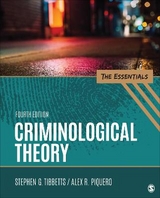
Criminological Theory
SAGE Publications Inc (Verlag)
978-1-5063-6789-7 (ISBN)
- Titel erscheint in neuer Auflage
- Artikel merken
Stephen G. Tibbetts, currently a Professor at California State University, San Bernardino, has been pursuing an understanding of criminal offending for over the past two decades. He has attempted to discover the extent to which individuals’ inherent dispositions and attitudinal traits contribute to their offending decisions, especially in relation to other factors, such as demographic, developmental, and situational factors. Dr. Tibbetts’ research has included work on the differences between men and women in their decisions to commit deviant behavior, as well as their perceptions of risk and consequences of getting caught. His additional research interests include the effects of perinatal disorders as an influence in future criminality, the etiology of white-collar crime, and gang intervention. Dr. Tibbetts has published nine books and more than 50 scholarly papers examining various issues in criminology. He received the 2011 Outstanding Professor Award at CSU, San Bernardino. He previously worked extensively as an Officer of the Court in providing recommendations for dispositions of numerous juvenile court cases from 1997 to 2008.
Preface
CHAPTER 1. Introduction to the Book: An Overview of Issues in Criminological Theory
What Is Criminology, and How Does It Differ from Other Examinations of Crime?
What Is Theory?
What Is Crime?
How Are Criminological Theories Classified? The Major Theoretical Paradigms
Characteristics of Good Theories
Measures of Crime
Rates of Crime
Policy Implications
Conclusion
CHAPTER SUMMARY
KEY TERMS
DISCUSSION QUESTIONS
WEB RESOURCES
CHAPTER 2. Preclassical and Classical Theories of Crime
Preclassical Perspectives of Crime and Punishment
The Age of Enlightenment
The Classical School of Criminology
The Neoclassical School of Criminology
Loss of Dominance of Classical and Neoclassical Theory
Policy Implications
Conclusion
CHAPTER SUMMARY
KEY TERMS
DISCUSSION QUESTIONS
WEB RESOURCES
CHAPTER 3. Modern Applications of the Classical Perspective: Deterrence, Rational Choice, and Routine Activities or Lifestyle Theories of Crime
The Rebirth of Deterrence Theory and Contemporary Research
Rational Choice Theory
Routine Activities Theory
Policy Implications
Conclusion
CHAPTER SUMMARY
KEY TERMS
DISCUSSION QUESTIONS
WEB RESOURCES
CHAPTER 4. Early Positive School Perspectives of Criminality
Lombroso’s Theory of Atavism and Born Criminals
The IQ Testing Era
Body Type Theory: Sheldon’s Model of Somatotyping
Policy Implications
Conclusion
CHAPTER SUMMARY
KEY TERMS
DISCUSSION QUESTIONS
WEB RESOURCES
CHAPTER 5. Modern Biosocial Perspectives of Criminal Behavior
Nature versus Nurture: Studies Examining the Influence of Genetics and Environment
Cytogenetic Studies: The XYY Factor
Hormones and Neurotransmitters: Chemicals That Determine Criminal Behavior
Brain Injuries
Central and Autonomic Nervous System Activity
Biosocial Approaches to Explaining Criminal Behavior
Policy Implications
Conclusion
CHAPTER SUMMARY
KEY TERMS
DISCUSSION QUESTIONS
WEB RESOURCES
CHAPTER 6. Early Social Structure and Strain Theories of Crime
Early Theories of Social Structure: Early to Mid-1800s
Strain Theories
Policy Implications
Conclusion
CHAPTER SUMMARY
KEY TERMS
DISCUSSION QUESTIONS
WEB RESOURCES
CHAPTER 7. The Chicago School and Cultural and Subcultural Theories of Crime
The Ecological School and the Chicago School of Criminology
Cultural and Subcultural Theories of Crime
Policy Implications
Conclusion
CHAPTER SUMMARY
KEY TERMS
DISCUSSION QUESTIONS
WEB RESOURCES
CHAPTER 8. Social Process and Learning Theories of Crime
Learning Theories
Control Theories
Policy Implications
Conclusion
CHAPTER SUMMARY
KEY TERMS
DISCUSSION QUESTIONS
WEB RESOURCES
CHAPTER 9. Social Reaction and Critical Models of Crime
Labeling and Social Reaction Theory
Marxist Theories of Crime
Conflict Theories of Crime
Policy Implications
Conclusion
CHAPTER SUMMARY
KEY TERMS
DISCUSSION QUESTIONS
WEB RESOURCES
CHAPTER 10. Feminist Models of Crime
Feminist Theories of Crime
Key Terms in the Feminist Perspective
Key Issues in Research on Gender Differences in Offending
Types of Feminism
Critiques of Feminist Theories
Policy Implications
Conclusion
CHAPTER SUMMARY
KEY TERMS
DISCUSSION QUESTIONS
WEB RESOURCES
CHAPTER 11. Life-Course Perspectives of Criminality
Developmental Theories
Policy Implications
Conclusion
CHAPTER SUMMARY
KEY TERMS
DISCUSSION QUESTIONS
WEB RESOURCES
CHAPTER 12. Integrated Theoretical Models and New Perspectives of Crime
Integrated Theories
Policy Implications
Conclusion
CHAPTER SUMMARY
KEY TERMS
DISCUSSION QUESTIONS
WEB RESOURCES
Glossary
Index
About the Author
| Erscheinungsdatum | 16.03.2018 |
|---|---|
| Verlagsort | Thousand Oaks |
| Sprache | englisch |
| Maße | 187 x 231 mm |
| Gewicht | 500 g |
| Themenwelt | Recht / Steuern ► Strafrecht ► Kriminologie |
| Sozialwissenschaften ► Soziologie ► Allgemeine Soziologie | |
| ISBN-10 | 1-5063-6789-5 / 1506367895 |
| ISBN-13 | 978-1-5063-6789-7 / 9781506367897 |
| Zustand | Neuware |
| Haben Sie eine Frage zum Produkt? |
aus dem Bereich



